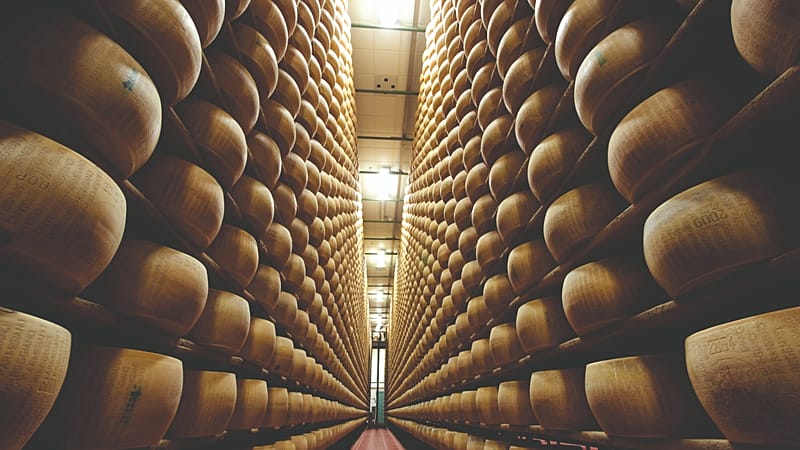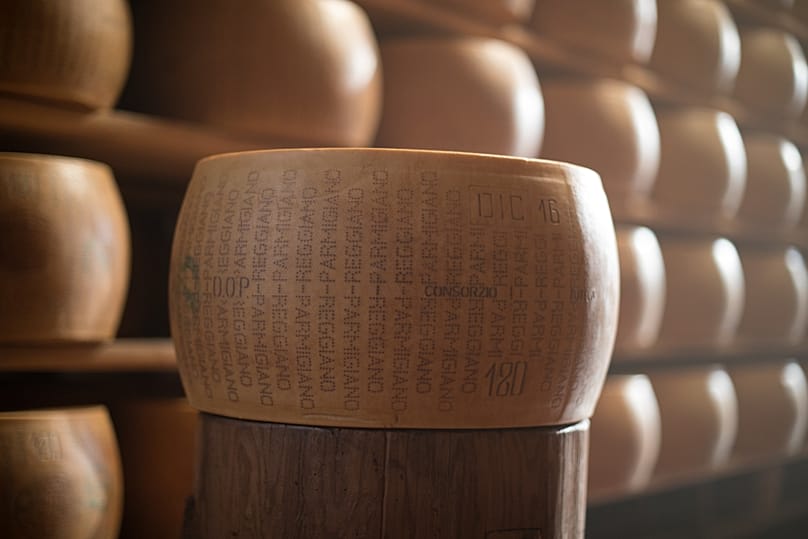Inside Italy’s ultimate cheese festival: Parma opens its dairies for Caseifici Aperti

As a tour group pauses between rows of Parmigiano Reggiano stacked to the ceiling, an Italian woman explains how she smuggles wedges of the cheese to her sister.
“No one ever looks twice at thoroughbreds,” she says, as if hiding cheese in horseboxes were the most natural thing in the world. An affineur’s hammer echoes in the distance — tap, tap, tap — and the room falls silent. These cheese professionals specialise in the process of maturing and ageing young cheeses to develop their full flavour, texture, and aroma.
It might sound like a joke, but in Parma, devotion to Parmigiano Reggiano runs deep. And at no time does that passion feel more alive than during Caseifici Aperti, when dairies across Emilia-Romagna open their doors so visitors can find out what makes Italy’s most famous cheese so beloved.
A rare invitation
Caseifici Aperti, or “Open Dairies”, is Parmigiano Reggiano’s access-all-areas weekend. Held twice a year in spring and autumn, it invites the public to see how the cheese is made and why the strict rules behind it still matter.
Thousands of visitors flock to hundreds of dairies that open across the Emilia-Romagna region between Parma, Bologna, Reggio Emilia, Modena and Mantua.
One of the most prominent is Azienda Agricola Bertinelli.Run by the Bertinelli farming dynasty since 1895, it hosts tours, workshops and tastings at its dairy on the outskirts of Parma.
“Caseifici Aperti lets everyone, from the curious to fully fledged foodies, participate in the birth of a wheel, walk the maturing warehouses and buy cheese directly from the artisan who made it,” says Nicola Bertinelli, the 6th generation owner of Azienda Agricola Bertinelli.
“It is a real journey through time to discover an artisanal method that has remained unchanged for over nine centuries.”
For visitors weighing up dates, his advice is clear: “This is the moment when the entire territory opens its doors, and you feel the connection between people, animals and nature. It is the most complete way to understand why Parma’s food culture is recognised worldwide.”
Three ingredients, a thousand years
If you want to experience Parmigiano Reggiano being made, you need to arrive early. By seven or eight in the morning, visitors are filing past the milking sheds towards the make room, where copper, bell-shaped vats sit under bright lights and guides explain why dairies keep so much of the process on their own land.
The centuries-old recipe has changed very little since 1254, when Benedictine and Cistercian monks first devised large, long-keeping wheels to preserve surplus milk. Families like the Gennaris and Valserenas have kept that craft alive for generations. They still use local cow breeds such as the Italian Frisona and spino whisks made from hawthorn branches.
Today, at Azienda Agricola Bertinelli, the process remains vertically integrated, meaning they own the herd, produce the milk and grow the hay. This ensures, as required by the European Protected Designation of Origin (PDO), that every wheel has a flavour profile unique to its dairy.
Bertinelli recommends watching three moments closely.
“Pay attention to the curd when it is broken into small granules. It is very delicate and all about timing,” he says. “Then the lift, when the wheel takes shape inside the hoop, which shows true artisanal skill. And don’t miss the ageing rooms, the long corridors where flavour, texture and aroma evolve.”
These ageing rooms, often referred to as “cheese cathedrals”, are aisles of shelves running from floor to ceiling. After a brine bath and identity marking, the wheels rest here while fermentation continues. After 12 months, a Consortium inspector arrives with a small hammer to sound each wheel; clean, even notes indicate conformity to the PDO standard and earn the Parmigiano Reggiano fire-brand on the rind.
The scale of this room is also where the economics of Parmigiano Reggiano are most visible. Cheese wheels have long functioned as collateral because they increase in value over time, with several Italian banks still operating dedicated cheese vaults to this day.
What surprises visitors most, however, is the simplicity of the ingredients. “Milk, rennet and salt. No additives, no preservatives. Complexity comes from time and human ingenuity.”
A weekend of food and culture
During Caseifici Aperti, Parma is busy, and the best restaurants fill up quickly, so it makes sense to book ahead. Schedule dairy visits for the morning, when production is in full swing, and leave time in the afternoon to soak up the northern Italian city’s historic centre.
“If you have the whole day, be sure to have lunch in a local trattoria or visit a nearby producer of Prosciutto di Parma or Lambrusco wine,” says Bertinelli.
Between meals, the Cathedral of Santa Maria Assuntaand the Baptistery of San Giovanni Battista both sit in the Piazza Duomo, making a neat cultural stop. The Palazzo della Pilotta is a larger complex that houses museums, galleries and performance spaces and can comfortably fill an hour or two. Many city-run museums also offer free entry on certain days, so it is worth checking local listings before you set off.
Keeping the legend alive
In a world of lookalikes, Caseifici Aperti celebrates an Italian culinary icon. The PDO, which has faced repeated challenges from imitation cheeses abroad, continues to hold firm after 25 years. This is just one of the reasons why local affineurs and cheesemakers are so committed to putting this process on show.
“The main goal is to create connection and knowledge,” says Bertinelli. “More than 22,000 visitors joined the 2024 edition, and about 85 per cent of them bought cheese from the dairies, directly supporting local producers.” This impact is as cultural as it is economic. “Every visitor becomes an ambassador of the PDO and of the values it represents.”
A weekend in Parma during Caseifici Aperti leaves you with a clear sense of why Parmigiano Reggiano is at the centre of Emilia-Romagna food culture, and a strong urge to bring a wedge home by any means necessary.
Casefici Apertiruns on the first weekends of May and October in Parma and across the Emilia-Romagna region.




